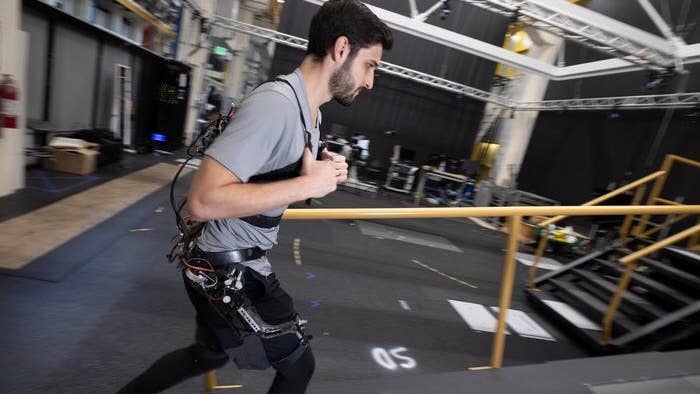Researchers Are Building Universal Exoskeletons Anyone Can Use

Share
Robotic exoskeletons could help disabled people regain their mobility, factory workers lift heavier loads, or athletes run faster. So far, they've been largely restricted to the lab due to the need to painstakingly calibrate them for each user, but a new universal controller could soon change that.
While the word “exoskeleton” might evoke sci-fi images from movies like Alien and Avatar, the technology is edging its way towards the real world. Exoskeletons have been tested as a way to prevent injuries in car factories, let soldiers lug around heavy packs for longer, and even help people with Parkinson’s stay mobile.
But the software controlling how much power to apply in support of a user’s limbs typically has to be carefully tweaked to fit each individual. Also, it normally only helps with a few predetermined movements it's specially designed for.
A new approach by researchers at the Georgia Institute of Technology uses neural networks to seamlessly adapt an exoskeleton’s movements to each user’s particular posture and gait. The team says this could help get the technology out of the lab and start aiding people in everyday life.
“What’s so cool about this is that it adjusts to each person's internal dynamics without any tuning or heuristic adjustments, which is a huge difference from a lot of work in the field,” Aaron Young, who led the research, said in a press release.
Exoskeletons use electric motors to provide extra power to a user’s limbs when carrying out strenuous activities. Most control schemes have focused on assisting well-defined activities, such as walking or climbing stairs.
A common approach, the researchers say, is to have a high-level algorithm predict what action the user is trying to take and then, when that activity is detected, initiate a special control scheme designed for that kind of movement.
This means the exoskeleton can only assist specific activities, and even if the device supports several different ones, users often have to toggle between them by pressing a button. What’s more, it means the device needs to be carefully adjusted so its control scheme matches the unique shape and dynamics of each user’s limbs.
Be Part of the Future
Sign up to receive top stories about groundbreaking technologies and visionary thinkers from SingularityHub.


The new approach designed by the Georgia Tech team and described in a paper in Science Robotics, instead focuses on what a user’s joints and muscles are doing at any particular point in time and providing powered support to them continuously. Their approach was tested in a hip exoskeleton, which the researchers say is useful in a wide range of scenarios.
A neural network running on a GPU chip reads data from several sensors on the exoskeleton that measure the angle of different joints and the user’s direction and speed. It uses this information to predict what movements the user is making and then directs the exoskeleton’s motors to apply just the right amount of torque to take some of the load off the relevant muscles.
The team trained the neural network on data from 25 participants walking in a variety of contexts while wearing the exoskeleton. This helped the algorithm gain a general understanding of how sensor data related to muscle movements, making it possible to automatically adapt to new users without being tailored to their idiosyncrasies.
The study showed the resulting system could significantly reduce the amount of energy users expended in a variety of activities. While the reduction in energy use was similar to previous approaches, crucially, it was not restricted to particular actions and could provide continuous support no matter what the user was doing.
While the researchers say it’s too early to know if the approach will translate to other kinds of exoskeletons, it seems the overarching idea is relatively adaptable. That suggests exoskeletons could soon become an “off-the-shelf” product assisting people in a wide range of strenuous activities.
Image Credit: Candler Hobbs, Georgia Institute of Technology
Related Articles

These Robots Are the Size of Single Cells and Cost Just a Penny Apiece

In Wild Experiment, Surgeon Uses Robot to Remove Blood Clot in Brain 4,000 Miles Away

A Squishy New Robotic ‘Eye’ Automatically Focuses Like Our Own
What we’re reading
